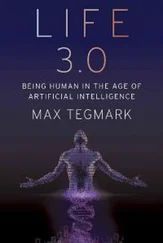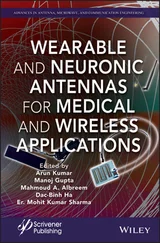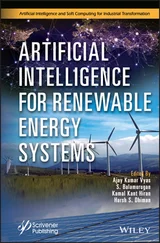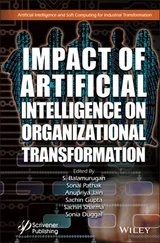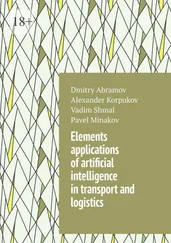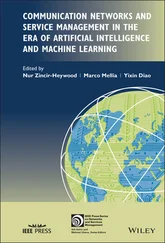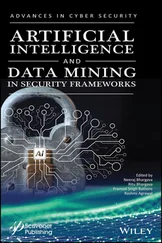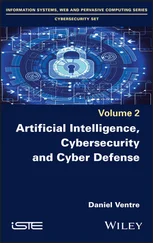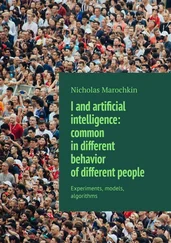Savo G. Glisic - Artificial Intelligence and Quantum Computing for Advanced Wireless Networks
Здесь есть возможность читать онлайн «Savo G. Glisic - Artificial Intelligence and Quantum Computing for Advanced Wireless Networks» — ознакомительный отрывок электронной книги совершенно бесплатно, а после прочтения отрывка купить полную версию. В некоторых случаях можно слушать аудио, скачать через торрент в формате fb2 и присутствует краткое содержание. Жанр: unrecognised, на английском языке. Описание произведения, (предисловие) а так же отзывы посетителей доступны на портале библиотеки ЛибКат.
- Название:Artificial Intelligence and Quantum Computing for Advanced Wireless Networks
- Автор:
- Жанр:
- Год:неизвестен
- ISBN:нет данных
- Рейтинг книги:3 / 5. Голосов: 1
-
Избранное:Добавить в избранное
- Отзывы:
-
Ваша оценка:
- 60
- 1
- 2
- 3
- 4
- 5
Artificial Intelligence and Quantum Computing for Advanced Wireless Networks: краткое содержание, описание и аннотация
Предлагаем к чтению аннотацию, описание, краткое содержание или предисловие (зависит от того, что написал сам автор книги «Artificial Intelligence and Quantum Computing for Advanced Wireless Networks»). Если вы не нашли необходимую информацию о книге — напишите в комментариях, мы постараемся отыскать её.
A practical overview of the implementation of artificial intelligence and quantum computing technology in large-scale communication networks Artificial Intelligence and Quantum Computing for Advanced Wireless Networks
Artificial Intelligence and Quantum Computing for Advanced Wireless Networks
Artificial Intelligence and Quantum Computing for Advanced Wireless Networks — читать онлайн ознакомительный отрывок
Ниже представлен текст книги, разбитый по страницам. Система сохранения места последней прочитанной страницы, позволяет с удобством читать онлайн бесплатно книгу «Artificial Intelligence and Quantum Computing for Advanced Wireless Networks», без необходимости каждый раз заново искать на чём Вы остановились. Поставьте закладку, и сможете в любой момент перейти на страницу, на которой закончили чтение.
Интервал:
Закладка:
The Authors
January 2021
Amherst, Massachusetts
1 Introduction
1.1 Motivation
Owing to the increase in the density and number of different functionalities in wireless networks, there is an increasing need for the use of artificial intelligence (AI) in planning the network deployment, running their optimization, and dynamically controlling their operation. Machine learning (ML) algorithms are used to predict traffic and network state in order to reserve resources for smooth communication with high reliability and low latency in a timely fashion. Big data mining is used to predict customer behavior and pre‐distribute (caching) the information content across the network in a timely fashion so that it can be efficiently delivered as soon as it is requested. Intelligent agents can search the Internet on behalf of the customer in order to find the best options when it comes to buying any product online. This book reviews ML‐based algorithms with a number of case studies supported by Python and R programs. It discusses the learning algorithms used in decision making based on game theory and a number of specific applications in wireless networks such as channel, network state, and traffic prediction.
We begin the book with a comprehensive survey of AI learning algorithms. These algorithms are used in the prediction of the network parameters for efficient network slicing, customer behavior for content caching across the network, or for efficient network control and management. Subsequently, we focus on network applications with an emphasis on AI‐based learning algorithms used for reaching equilibria in games used among different parties in a variety of new business models in communication networks. This includes competition between network operators, service providers, or even users in dynamic network architectures of user‐provided networks.
The book also covers in detail a number of specific applications of AI for dynamic readjusting network behavior based on the observation of its state, traffic variation, and user behavior. This includes channel and power level selection in cellular networks, network self‐organization, proactive caching, big data learning, graph neural network (GNN), and multi‐armed bandit estimators.
Why quantum computing? The ever‐reducing transistor size following Moore’s law is approaching the point where quantum effects predominate in transistor operation. This specific trend implies that quantum effects become unavoidable, hence making research on quantum computing (QC) systems an urgent necessity. In fact, a quantum annealing chipset is already commercially available from D‐Wave1.
Apart from the quantum annealing architecture, gate‐based architecture, which relies on building computational blocks using quantum gates in a similar fashion to classical logic gates, is attracting increasing attention due to the recent advances in quantum stabilizer codes, which are capable of mitigating the de‐coherence effects encountered by quantum circuits. In terms of implementation, IBM has initially produced 53-qubits quantum computer [1] and plans to have 1-million qubits by 2030 [2]. D-Wave Two 512 qubit processors [3] are built in Google and NASA quantum computer. With this recent developments, Quantum computing has become a commercial reality and it may be used in wireless communications systems in order to speed up specific processes due to its inherent parallelization capabilities.
Whereas a classical bit may adopt the values 0 or 1, a quantum bit, or qubit, may have the values |0>, |1>, or any superposition of the two, where the notation |> is the column vector of a quantum state. If two qubits are used, then the composite quantum state may have the values |00>, |01>, |10>, and |11> simultaneously. In general, by employing b bits in a classical register, one out of b 2combinations is represented at any time. By contrast, in a quantum register associated with b qubits, the composite quantum state may be found in a superposition of all b 2values simultaneously. Therefore, applying a quantum operation to the quantum register would result in altering all b 2values at the same time. This represents the parallel processing capability of quantum computing.
In addition to superior computing capabilities, multiple quantum algorithms have been proposed, which are capable of outperforming their classical counterparts in the same categories of problems, by either requiring fewer computational steps, or by finding a better solution to the specific problem. In this book, we will focus on the employment of quantum algorithms in classical communication systems, which is nowadays referred to as quantum‐assisted communications.
In the following sections, we revisit the ML methods in the context of quantum‐assisted algorithms for ML and the quantum machine learning (QML) framework. Quantum principles based on emerging computing technologies will bring in entirely new modes of information processing. An overview of supervised, unsupervised, and reinforcement learning (RL) methods for QML is presented in this segment of the book.
Currently, 5G networks have entered into the commercialization phase, which makes it appropriate to launch a strong effort to conceptualize the future vision of the next generation of wireless networks. The increasing size, complexity, services, and performance demands of communication networks necessitate planning and consultation for envisioning new technologies to enable and harmonize future heterogeneous networks. An overwhelming interest in AI methods is seen in recent years, which has motivated the provision of essential intelligence to 5G networks. However, this provision is limited to the performance of different isolated tasks of optimization, control, and management. The recent success of quantum‐assisted and data‐driven learning methods in communication networks has led to their candidature as enablers of future heterogeneous networks. This section reviews a novel framework for 6G/7G networks, where quantum‐assisted ML and QML are proposed as the core enablers along with some promising communication technology innovations.
The relevance of the research fields integrated throughout this book can be easily recognized within the National Science Foundation (NSF) list of research priorities in science and technology: These 10 areas specified by NSF include (i) AI and ML; (ii) high performance computing, semiconductors, and advanced computer hardware; (iii) quantum computing and information systems; (iv) robotics, automation, and advanced manufacturing; (v) natural or anthropogenic disaster prevention; (vi) advanced communications technology; (vii) biotechnology, genomics, and synthetic biology; (viii) cybersecurity, data storage, and data management technologies; (ix) advanced energy; and (x) materials science, engineering, and exploration relevant to other key technology areas. The 10 areas would be revisited every four years.
1.2 Book Structure
The first part of the book covers selected topics in ML, and the second part presents a number of topics from QC relevant for networking.
Chapter 2(Machine Learning Algorithms): This chapter presents an introductory discussion of many basic ML algorithms that are often used in practice and not necessary directly related to networking problems. However, they will present a logical basis for developing more sophisticated algorithms that are used nowadays to efficiently solve various problems in this field. These algorithms include linear regression, logistic regression, decision tree (regression trees vs. classification trees), and working with decision trees [4] in R and Python. In this chapter, we answer the questions: What is bagging? What is random forest? What is boosting? Which is more powerful: GBM or XGBoost? We also explain the basics of working in R and Python with GBM, XGBoost, SVM (support vector machine), Naive Bayes, kNN, K‐means, random forest, dimensionality reduction algorithms [5, 6], gradient boosting algorithms, GBM, XGBoost, LightGBM, and CatBoost [7, 8].
Читать дальшеИнтервал:
Закладка:
Похожие книги на «Artificial Intelligence and Quantum Computing for Advanced Wireless Networks»
Представляем Вашему вниманию похожие книги на «Artificial Intelligence and Quantum Computing for Advanced Wireless Networks» списком для выбора. Мы отобрали схожую по названию и смыслу литературу в надежде предоставить читателям больше вариантов отыскать новые, интересные, ещё непрочитанные произведения.
Обсуждение, отзывы о книге «Artificial Intelligence and Quantum Computing for Advanced Wireless Networks» и просто собственные мнения читателей. Оставьте ваши комментарии, напишите, что Вы думаете о произведении, его смысле или главных героях. Укажите что конкретно понравилось, а что нет, и почему Вы так считаете.

